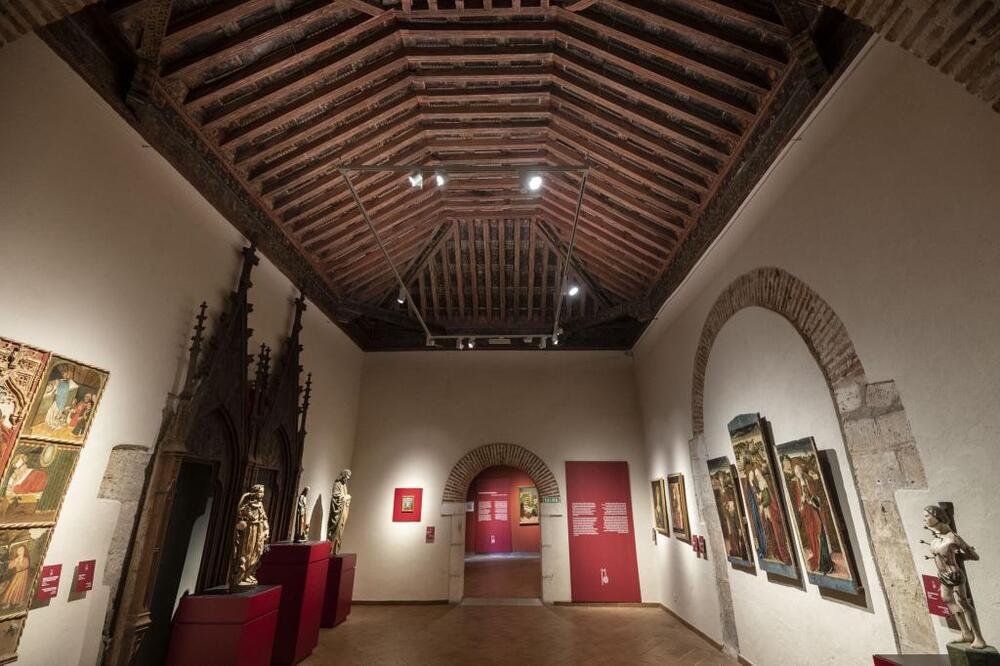The museum of the Collegiate Church of San Cosme and San Damián de Covarrubias is the great unknown of the province, despite the artistic wealth that the more than one hundred pieces of its four exhibition halls hold, some signed by teachers of the School of Covarrubias, Gil and Diego de Siloé, Pedro Berruguete, Gregorio Fernández or Jan van Eyck.
It is one of the few parish museum centers of the diocese of Burgos, which has now set itself the goal of promoting it educationally and touristically so that it is “an engine of cultural and rural development, much needed in today’s depopulated Spain”, as explained by the new director of the same, Cecilio Haro, parish priest of Mahamud and of another dozen towns in the region of Arlanza, and recently appointed deputy delegate of the Patrimony of the Diocese, that is, the right arm of Juan Álvarez de Quevedo. In addition to this task, Haro takes care of making an inventory of all the heritage of the museums and churches in the museum in the southern area of the Diocese.
The Archbishopric has entrusted this Heritage expert, who trained for several years in Rome, and who is currently studying a Masters in Heritage and Communication at the UBU, to give visibility to this 93-year-old museum, since was created in 1929 with remains and pieces of sculpture and painting from the altarpieces of the two primitive churches of Covarrubias, that of Santo Tomas and that of San Cosme and San Damián, temples currently open for worship, but which were built on previous .
The visit begins in the cloister in front of Princess Kristina’s tomb. – Photo: Jesús J. Matías
For decades it could have been considered an exhibition shop rather than a museum, explain Haro and Manuel Heras, the parish guide. It was the result of the celebration in 2019 of the Las Edades de Hombre exhibition in Lerma, when it was used to enhance other monuments in the Arlanza region and to reform that space with its musealisation, giving it a more didactic function. and professional with the placement of information panels and sorting by rooms.
The museum therefore consists of four exhibition areas, including an annex to the sacristy. The reform that its new manager is now proposing goes further, because it aims to place this museum center in the place it deserves for its artistic quality, as well as using new technological tools for its promotion and dissemination of its contents.
Add more attractions. The ambitious project that Cecilio Haro is already working on covers various lines of action and has a solid basis in the work that the Deputy Delegate for Heritage himself carried out in the monastery of San Salvador de Oña during the time in which he governed the fortunes of the same. On the one hand, the presence on social networks will be strengthened, a website will be created and marketing campaigns will be launched, as well as setting up a small merchandising point of sale.

Haro understands that in today’s society this virtual presence is not only necessary, but also mandatory for the cultural and tourist promotion that attracts more visitors to the city, without neglecting the edition of the traditional triptychs. This idea also seeks to exploit the value of ‘call’ that Covarrubias and the other two towns that make up the so-called Arlanza triangle already have, such as Silos and Lerma.
The second point of the project will focus on the museum facilities. On the one hand, the intention is to rearrange the route to define the entrance and exit, which are currently being built on the same site as the church, which would imply a small adjustment job on some of the stairs.
Furthermore, it is proposed to expand the museum with a new room, incorporating the space that still remains of the sacristy to exhibit its valuable stalls. Likewise, the visit will be completed (for groups only) with access to the Parochial Historical Archive, a space that houses interesting books and documents, including the foundation deed, in Visigothic characters, of the Infantado de Covarrubias, who on November 24th was 1148 years old.
Another of the ideas Cecilio Haro is working on is to incorporate the church of Santo Tomás into the tourist route of the groups, thus forming a package that includes the two temples of the city, the cloister, the archive and the museum of San Cosme and San Damiano.
This project would mean ‘altering’, that is organizing worship in the Collegiate Church, so that both the objectives, the liturgical and the tourist one, do not interfere, especially in the periods of greatest concentration of visitors, spring, summer and October. The latter is a month of great tourist influx -1,700 visits were registered-, largely due to the beginning of the school year and other activities of various associations and the planning of excursions in the city.
On the other hand, they want to professionalize the museum, so that the two people who currently work there as volunteers become parish workers, which would create two jobs, says the director, who adds that if more staff were needed, the diocese of Burgos could make more contracts.


